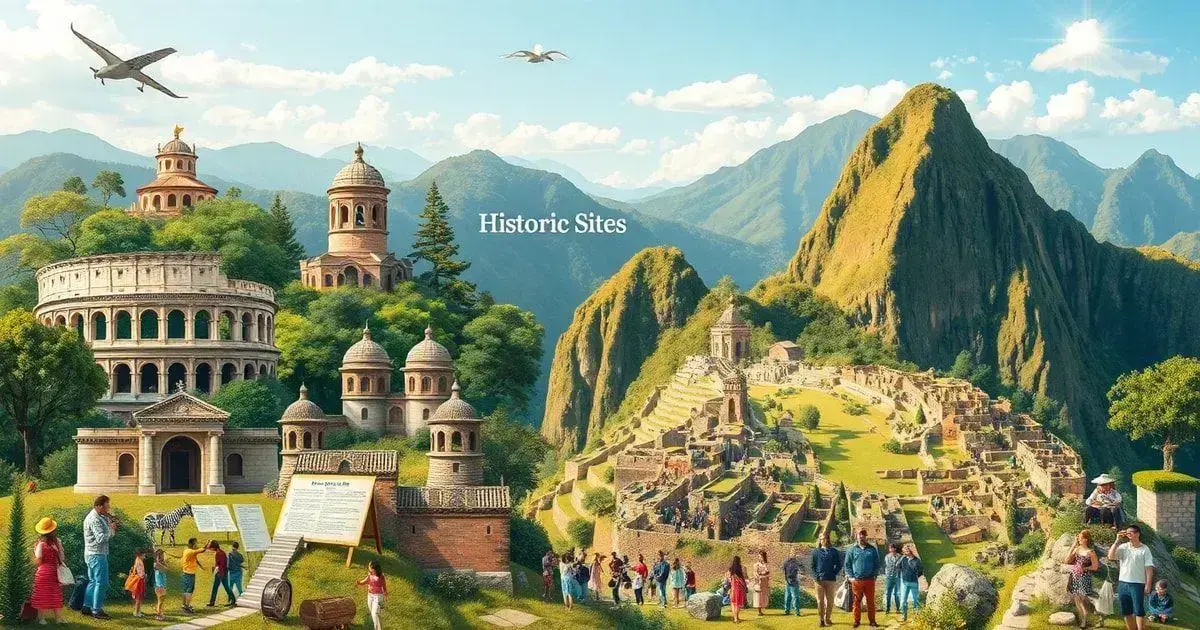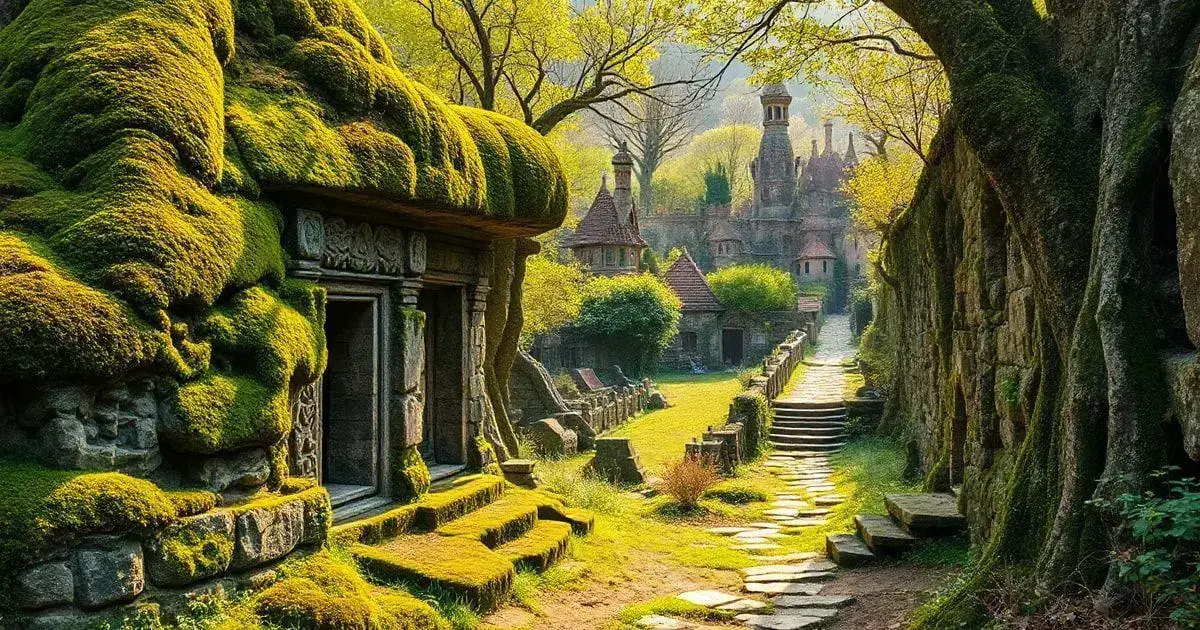Índice
Are you ready to discover Historic Destinations that bring the past to life? These remarkable sites offer a window into history, allowing travelers to connect with the events and cultures that shaped our world.
From ancient ruins to preserved landmarks, Historic Destinations provide unforgettable experiences filled with rich stories and traditions. Each location holds the power to transport you to another era, making your journey both educational and inspiring.
Embrace the opportunity to explore these iconic places and create memories that will deepen your appreciation for history. Let these destinations guide you on an adventure through time!
Top 10 Historic Destinations to Visit
When you explore historic destinations, you’ll discover places that have shaped our world. Here are the top 10 historic sites you must visit:
- The Great Wall of China – A marvel of ancient engineering, this wall stretches over 13,000 miles.
- The Pyramids of Giza – These iconic structures are a testament to the ingenuity of ancient Egyptians.
- The Colosseum in Rome – An architectural masterpiece, it’s a reminder of Rome’s glorious past.
- Stonehenge – This prehistoric monument continues to fascinate scholars and tourists alike.
- Machu Picchu – Hidden in the Andes, this ancient Incan city is breathtaking.
- The Acropolis – A symbol of ancient Greece, showcasing stunning temples.
- Chichén Itzá – A major Mayan site, known for its impressive pyramids.
- Angkor Wat – The largest religious monument in the world, rich in history.
- The Alhambra – A beautiful palace that reflects the glory of Moorish architecture.
- Versailles Palace – A grand symbol of royal opulence and history.
Each of these destinations offers a unique glimpse into our shared history. Visiting them is not just a tour but a journey back in time.
The Importance of Preserving Historic Sites

Preserving historic sites is crucial for maintaining our cultural heritage. These sites tell the stories of our past and connect us to our history. When we protect these places, we ensure that future generations can learn from them.
Here are some reasons why preserving historic sites matters:
- Education: Historic sites serve as living classrooms. They allow us to learn about different cultures and significant events.
- Tourism: Many travelers seek out historic destinations. This brings economic benefits to local communities.
- Community Identity: Historic sites provide a sense of belonging and continuity for residents.
- Environmental Impact: Old buildings can be environmentally friendly when they are reused or restored, rather than demolished.
- Research: They offer opportunities for archaeologists and historians to study the past.
- Aesthetic Value: Many historic structures have unique architectural features that enhance a community’s beauty.
By understanding the importance of these sites, we can take action to preserve them for the enjoyment and education of future generations.
How to Plan Your Journey to Historic Locations
Planning your journey to historic locations can be an exciting adventure. Here are some steps to help you prepare:
Research Your Destinations: Start by looking up the historic sites you want to visit. Use travel blogs, websites, and guidebooks to gather information.
Check Opening Hours: Ensure that the sites are open on the days you plan to visit. Some places may have limited hours or require tickets.
Plan Your Route: Map out the sites you want to see to avoid wasting time. Consider using public transport or guided tours for convenience.
Pack Accordingly: Depending on the destination, pack comfortable shoes for walking and a camera to capture the memories.
Learn About the History: Understanding the significance of each site enhances your experience. Read about their background and stories.
Respect the Sites: Follow rules and guidelines to preserve the integrity of historic locations. Stay on paths and do not disturb artifacts.
Engage with Locals: Talk to local guides or residents to gain insights about the history and culture of the area.
Enjoy the Experience: Take your time to explore, and be open to discovering new things about each place.
By following these steps, you can make your visit to historic locations enjoyable and memorable.
Guided Tours vs. Solo Exploration: Which is Better?

When visiting historic destinations, travellers often face a choice: guided tours or exploring solo. Both options have their benefits, and understanding these can enhance your experience.
Guided Tours: Provide expert knowledge about the site. Guides share interesting stories and important facts that you may not find in books.
Convenience: With a guided tour, everything is organised for you, from transport to entry fees. This is ideal if you prefer a stress-free experience.
Social Interaction: Tours allow you to meet fellow travellers, possibly forming friendships and sharing experiences.
Time Efficiency: Guides often know the best times to visit certain areas, helping you avoid crowds.
Solo Exploration: Allows for a more personal experience. You can take your time, explore at your own pace, and focus on what interests you the most.
Flexibility: There’s no schedule to follow, so you can change plans on a whim.
Personal Discovery: Exploring alone can lead to unexpected findings and a deeper connection to the places you visit.
Cost-Effective: Solo travel tends to be less expensive. You can save on guide fees and choose your accommodations and meals based on your budget.
Ultimately, the choice between guided tours and solo exploration depends on your personal preferences and travel style. Both can offer valuable insights into historic sites and create lasting memories.
Cultural Festivals in Historic Destinations
Cultural festivals in historic destinations are vibrant celebrations that showcase a region’s heritage. These events not only attract tourists but also bring communities together.
Here are some of the most notable cultural festivals you should explore:
1. Diwali: Celebrated across India, this festival of lights signifies the victory of light over darkness. Cities like Varanasi and Delhi host grand celebrations.
2. Mardi Gras: In New Orleans, USA, this festival features parades and masquerade balls, highlighting the city’s unique blend of cultures.
3. Oktoberfest: Held in Munich, Germany, this beer festival is a major event showcasing Bavarian culture, traditional foods, and music.
4. Chinese New Year: Many cities with significant Chinese populations celebrate with parades, dragon dances, and delicious food, making it a vibrant occasion.
5. Edinburgh Festival Fringe: This is the world’s largest arts festival, featuring performances from theatre to comedy across the historic city.
6. La Tomatina: This unique festival in Spain sees participants throwing tomatoes at each other, making for a fun and messy experience.
7. Songkran: Thailand’s New Year water festival involves lively street parties and cultural rituals, showcasing the country’s rich traditions.
8. Hogmanay: This Scottish New Year celebration is filled with music, fireworks, and traditions that reflect the nation’s heritage.
Attending these festivals allows you to engage with local customs and gain a deeper understanding of the culture within these historic locations. They offer a unique way to connect with history while enjoying vibrant, festive atmospheres.
Unusual Historic Sites Off the Beaten Path

When you explore unusual historic sites off the beaten path, you discover hidden gems that tell unique stories. These sites are often less crowded, allowing for a more intimate experience.
Here are some fascinating places to consider visiting:
- Alhambra, Spain – This stunning palace and fortress complex showcases exquisite Islamic architecture and beautiful gardens.
- Pompeii, Italy – An ancient city preserved by volcanic ash, giving insights into life in the Roman Empire.
- Chichen Itza, Mexico – A renowned Mayan site featuring the famous pyramid of Kukulcan.
- Tikal, Guatemala – A significant Mayan ruin located in the jungle, it offers breathtaking temples and wildlife.
- Gjirokastër, Albania – A UNESCO World Heritage site, this city is known for its well-preserved Ottoman architecture.
- Hashima Island, Japan – An abandoned coal mining facility that tells the story of industrialisation in Japan.
- The Great Zimbabwe – The ruins of this ancient city are a testament to the engineering skills of the Shona people.
- Banaue Rice Terraces, Philippines – Often called the “Eighth Wonder of the World,” these terraces showcase centuries-old agricultural practices.
Visiting these unusual historic sites allows travellers to step away from typical tourist paths and immerse themselves in rich history and culture. Each destination has its own charm and story that could enrich your understanding of the world.
Tips for Documenting Your Travels to Historic Places
Documenting your travels to historic places can be a rewarding experience. Here are some tips to help you capture those moments effectively:
Keep a Travel Journal: Write down your thoughts and experiences each day. Include details about the sites you visit.
Take Pictures: Capture images not only of the sites but also of the people and culture around you. Photos can help tell the story.
Use Historical Context: Research the history of the places you visit and include that information in your documentation.
Collect Souvenirs: Keep tickets, brochures, and other memorabilia. These can evoke memories later on.
Engage with Locals: Talk to residents or guides. Their stories can deepen your understanding of the site.
Use Social Media: Share your experiences on platforms like Instagram or Facebook to connect with others who have similar interests.
Create a Blog: Consider starting a travel blog to document your journeys. This way, you can share your insights and inspire others.
Review your Notes: After your trip, go through your journal and photos. Consider what you learned and how it changed your views.
By following these tips, you will create lasting memories and insightful documentation of your visits to historic places.
The Future of Historic Preservation in Tourism

The future of historic preservation in tourism is bright, as more people seek authentic experiences. Here are some key trends that are shaping the future:
Increased Awareness: More tourists are becoming aware of the importance of preserving cultural heritage and are looking for destinations that prioritise sustainable tourism.
Technology Integration: Technology aids preservation efforts through digital archiving, virtual tours, and augmented reality experiences that bring history to life.
Community Involvement: Local communities are playing a bigger role in preservation. Involving them helps to protect heritage while also benefiting local economies.
Government Support: Many governments are implementing policies to protect historic sites and promote them as tourist attractions.
Eco-Tourism: There is a shift towards eco-friendly tourism. Sustainable practices help to preserve historic locations and the surrounding environment.
Educational Initiatives: Schools and organisations are creating programs focused on the significance of cultural heritage, encouraging young people to appreciate history.
Partnerships: Collaboration between heritage organisations and tourism boards helps to streamline preservation efforts and promote responsible tourism.
Adaptive Reuse: Historic buildings are being repurposed for modern use, allowing for preservation while making them relevant in today’s society.
By embracing these trends, the tourism industry can ensure that historic preservation remains a priority, enabling future generations to enjoy these invaluable sites.
Embracing Our Historic Heritage
As we explore the rich tapestry of our history through various historic destinations, it becomes clear that preservation is vital for future generations.
Cultural festivals, unusual sites, and the active involvement of local communities in tourism help in maintaining the stories and significance of these places.
By documenting our travels and making informed choices about our journeys, we contribute to a better understanding and appreciation of our shared past.
Ultimately, combining modern technology and traditional knowledge will ensure that the legacy of historic sites remains vibrant and relevant in an ever-changing world.
